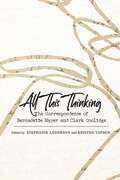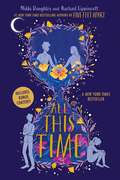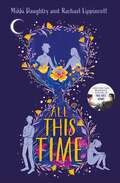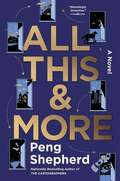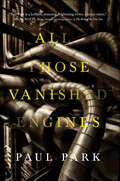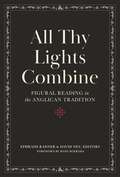- Table View
- List View
All This Thinking: The Correspondence of Bernadette Mayer and Clark Coolidge (Recencies Series: Research and Recovery in Twentieth-Century American Poetics)
by Stephanie Anderson and Kristen TapsonAll This Thinking explores the deep friendship and the critical and creative thinking between Bernadette Mayer and Clark Coolidge, focusing on an intense three-year period in their three decades of correspondence. These fiercely independent American avant-garde poets have influenced and shaped poets and poetic movements by looking for radical poetics in the everyday. This collection of letters provides insight into the poetic scenes that followed World War II while showcasing the artistic practices of Mayer and Coolidge themselves. A fascinating look at both the poets and the world surrounding them, All This Thinking will appeal to all readers interested in post–World War II poetry.
All This Time
by Rachael Lippincott Mikki DaughtryFrom the team behind #1 New York Times bestseller Five Feet Apart comes a gripping new romance that asks: Can you find true love after losing everything? <P><P>Kyle and Kimberly have been the perfect couple all through high school, but when Kimberly breaks up with him on the night of their graduation party, Kyle’s entire world upends—literally. Their car crashes and when he awakes, he has a brain injury. Kimberly is dead. And no one in his life could possibly understand. <P><P>Until Marley. Marley is suffering from her own loss, a loss she thinks was her fault. And when their paths cross, Kyle sees in her all the unspoken things he’s feeling. As Kyle and Marley work to heal each other’s wounds, their feelings for each other grow stronger. But Kyle can’t shake the sense that he’s headed for another crashing moment that will blow up his life as soon as he’s started to put it back together. And he’s right. <P><P><b>A New York Times Bestseller</b>
All This Time
by Rachael Lippincott Mikki DaughtryFrom the authors behind Five Feet Apart, a #1 New York Times bestseller and hit movie, comes a gripping new romance, perfect for fans of The Perks of Being a Wallflower and The Fault in Our Stars Can you find true love after losing everything?Kyle and Kimberly have been the perfect couple all through high school, but when Kimberly breaks up with him on the night of their graduation party, Kyle&’s entire world upends - literally. Their car crashes and when he awakes, he has a brain injury. Kimberly is dead. And no one in his life could possibly understand. Until Marley. Marley is suffering from her own loss, a loss she thinks was her fault. As Kyle and Marley work to heal each other&’s wounds, their feelings for each other grow stronger. But Kyle can&’t shake the sense that he&’s headed for another crashing moment that will blow up his life as soon as he&’s started to put it back together. And he&’s right.An unforgettable novel perfect for fans of John Green, Nicola Yoon, David Levithan and Jenny Han
All This Twisted Glory (This Woven Kingdom #3)
by Tahereh MafiThe highly anticipated third novel in the This Woven Kingdom series, full of powerful magic, searing romance, and heartbreaking betrayal, from the award-winning and bestselling author of the Shatter Me series. Perfect for fans of Leigh Bardugo, Sabaa Tahir, and Tomi Adeyemi.As the long-lost heir to the Jinn throne, Alizeh has finally found her people—and she might’ve found her crown. Cyrus, the mercurial ruler of Tulan, has offered her his kingdom in a twisted exchange: one that would begin with their marriage and end with his murder.Cyrus’s dark reputation precedes him; all the world knows of his blood-soaked past. Killing him should be easy—and accepting his offer might be the only way to fulfill her destiny and save her people. But the more Alizeh learns of him, the more she questions whether the terrible stories about him are true.Ensnared by secrets, Cyrus has ached for Alizeh since she first appeared in his dreams many months ago. Now that he knows those visions were planted by the devil, he can hardly bear to look at her—much less endure her company. But despite their best efforts to despise each other, Alizeh and Cyrus are drawn together over and over with an all-consuming thirst that threatens to destroy them both.Meanwhile, Prince Kamran has arrived in Tulan, ready to exact revenge…Layered with exquisite tension and heart-stopping romance, All This Twisted Glory is the explosive third book in the captivating, bestselling This Woven Kingdom series.
All This and More: A Novel
by Peng ShepherdFrom the critically acclaimed, bestselling author of The Cartographers and The Book of M comes an inventive new novel about a woman who wins the chance to rewrite every mistake she’s ever made… and how far she’ll go to find her elusive “happily ever after.” But there’s a twist: the reader gets to decide what she does next to change her fate.One woman. Endless options. Every choice has consequences.Meek, play-it-safe Marsh has just turned forty-five, and her life is in shambles. Her career is stagnant, her marriage has imploded, and her teenage daughter grows more distant by the day. Marsh is convinced she’s missed her chance at everything—romance, professional fulfillment, and adventure—and is desperate for a do-over.She can’t believe her luck when she’s selected to be the star of the global sensation All This and More, a show that uses quantum technology to allow contestants the chance to revise their pasts and change their present lives. It’s Marsh’s only shot to seize her dreams, and she’s determined to get it right this time.But even as she rises to become a famous lawyer, gets back together with her high school sweetheart, and travels the world, she begins to worry that All This and More’s promises might be too good to be true. Because while the technology is amazing, something seems a bit off.…Can Marsh really make her life everything she wants it to be? And is it worth it?Perfect for fans of Matt Haig’s The Midnight Library and Kate Atkinson’s Life After Life, bestselling author Peng Shepherd’s All This and More is an utterly original, startlingly poignant novel that puts the reader in the driver’s seat.
All Those Broken Angels
by Peter Adam SalomonRichard Harrison was the last person to see his friend Melanie alive. She vanished when they were six, and while the police never found her, a part of her remained--a living shadow that became Richard's closest friend. For ten years, Richard has never questioned the shadow that keeps him company . . . until a new girl moves to town, claiming to be Melanie. All Those Broken Angels is a story of buried bones and shadowy secrets and the freedom that can only come from a journey through darkness.
All Those Explosions Were Someone Else's Fault: A Novel
by James Alan GardnerMonsters are real.But so are heroes.Sparks are champions of weird science. Boasting capes and costumes and amazing super-powers that only make sense if you don’t think about them too hard, they fight an eternal battle for truth and justice . . . mostly.Darklings are creatures of myth and magic: ghosts, vampires, were-beasts, and the like. Their very presence warps reality. Doors creak at their approach. Cobwebs gather where they linger. Kim Lam is an ordinary college student until a freak scientific accident (what else?) transforms Kim and three housemates into Sparks—and drafts them into the never-ending war between the Light and Dark. They struggle to master their new abilities—and (of course) to design cool costumes and come up with great hero-names.Turns out that “accident” was just the first salvo in a Mad Genius’s latest diabolical scheme. Now it’s up to four newbie heroes to save the day, before they even have a chance to figure out what their team’s name should be!At the Publisher's request, this title is being sold without Digital Rights Management Software (DRM) applied.
All Those Moments: Stories of Heroes, Villains, Replicants, and Blade Runners
by Rutger Hauer Patrick QuinlanThe Blade Runner star recounts his eventful life and acting career, from joining the merchant navy to working with Hollywood’s biggest directors.Rutger Hauer has dazzled audiences for years with his creepy, inspiring, and villainous character portrayals. He came to mainstream prominence as a machine more human than his creators in Blade Runner, terrified us as a hitchhiker bent on his own death in The Hitcher, and portrayed a lovestruck king who nightly transformed into a marauding wolf in Ladyhawke.While fans are well acquainted with Hauer’s unforgettable on-screen performances, his movie career was nothing compared to his real-life adventures. Born in the Netherlands during WWII, he grew up in a poor family that nourished his creativity. After travelling the world with the Dutch merchant navy, he pursued his love of acting. From working with a traveling theater troupe to his breakout European performance in Turkish Delight and working with legendary directors such as Paul Verhoeven (RoboCop and Basic Instinct) and Ridley Scott (Alien and Gladiator), Hauer has collected All Those Moments here.
All Those Vanished Engines
by Paul ParkIn All Those Vanished Engines, Paul Park returns to science fiction after a decade spent on the impressive four-volume A Princess of Roumania fantasy, with an extraordinary, intense, compressed SF novel in three parts, each set in its own alternate-history universe. The sections are all rooted in Virginia and the Battle of the Crater, and are also grounded in the real history of the Park family, from differing points of view. They are all gorgeously imaginative and carefully constructed, and reverberate richly with one another. The first section is set in the aftermath of the Civil War, in a world in which the Queen of the North has negotiated a two-nation settlement. The second, taking place in northwestern Massachusetts, investigates a secret project during World War II, in a time somewhat like the present. The third is set in the near-future United States, with aliens from history. At the Publisher's request, this title is being sold without Digital Rights Management Software (DRM) applied.
All Those Wonderful Names: A Potpourri Of People, Places And Things
by J. N. HookEver wonder what the most popular and unpopular baby names are? And how certain people and places got their names? Or are you just looking for guidance in choosing your child&’s name? ALL THOSE WONDERFUL NAMES is an amusing exploration of names, familiar words, phrases, and the stories behind their origins. From the common to the confounding, this book has it all. Hear the true stories behind the naming of tropical storms, cars, fictitious characters, major league baseball teams, and more. Find out the real names of celebrities, such as Elton John, Cher, Rip Torn, Cary Grant, Liberace, and Conway Twitty. Discover counties, towns, and cities with strange names like Difficult, Tennessee; Jiggs, Nevada; Virgin, Utah; and Bosom, Wyoming. Learn unusual names for newborns—and perhaps the origin of your own surname as well.
All Those Years Ago
by Emilie RichardsTeenage Meredith Robbins had experienced despair at the tragic loss of a special friend, then borne the anguish of having to give up their child. Now, years later, she painstakingly avoided emotional entanglements-until Garrett Quinn's warmth and sincerity challenged her to become a woman, awakening her to the need to see her child, just once. But if she faced the past, would she lose Garrett-and the future?
All Thoughts Are Equal: Laruelle and Nonhuman Philosophy (Posthumanities #34)
by John Ó MaoilearcaAll Thoughts Are Equal is both an introduction to the work of French philosopher François Laruelle and an exercise in nonhuman thinking. For Laruelle, standard forms of philosophy continue to dominate our models of what counts as exemplary thought and knowledge. By contrast, what Laruelle calls his &“non-standard&” approach attempts to bring democracy into thought, because all forms of thinking—including the nonhuman—are equal.John Ó Maoilearca examines how philosophy might appear when viewed with non-philosophical and nonhuman eyes. He does so by refusing to explain Laruelle through orthodox philosophy, opting instead to follow the structure of a film (Lars von Trier&’s documentary The Five Obstructions) as an example of the non-standard method. Von Trier&’s film is a meditation on the creative limits set by film, both technologically and aesthetically, and how these limits can push our experience of film—and of ourselves—beyond what is normally deemed &“the perfect human.&”All Thoughts Are Equal adopts film&’s constraints in its own experiment by showing how Laruelle&’s radically new style of philosophy is best presented through our most nonhuman form of thought—that found in cinema.
All Three Stooges
by Erica S. PerlAn unforgettable coming-of-age story about comedy, loss, and friendship for fans of Jennifer L. Holm and Gary D. Schmidt.Spoiler alert: This book is not about the Three Stooges. It's about Noah and Dash, two seventh graders who are best friends and comedy junkies. That is, they were best friends, until Dash's father died suddenly and Dash shut Noah out. Which Noah deserved, according to Noa, the girl who, annoyingly, shares both his name and his bar mitzvah day. Now Noah's confusion, frustration, and determination to get through to Dash are threatening to destroy more than just their friendship. But what choice does he have? As Noah sees it, sometimes you need to risk losing everything, even your sense of humor, to prove that gone doesn't have to mean "gone for good."Equal parts funny, honest, and deeply affecting, All Three Stooges is a book that will stay with readers long after the laughter subsides."Perl has created a moving coming-of-age journey steeped in Jewish traditions and comedic history, elegantly balancing humor with an honest look at the impact of suicide. Noah's genuine voice and tricky situation will have readers pulling for him."--Publishers Weekly"This novel is excellent on multiple fronts. A satisfying story that will appeal to all middle grade readers."--SLJ"Watching Noah repeatedly sliding on a banana peel (even, once, literally) gives readers plenty of occasions to wince, to chortle, and ultimately, to applaud."--Booklist
All Through The Night
by Mary Higgins ClarkAt the heart of the novel are two of Mary Higgins Clark's most loved characters: Alvirah, the lottery winner turned amateur sleuth, and her husband, Willy, who are caught up in a Christmas mystery that calls on all of their skills and experience. Willy has been looking forward to playing Santa at the after-school centre recently set up to care for the children of working parents on New York's Upper West Side, and Alvirah has been busy with rehearsals for the Christmas pageant. But suddenly a shadow falls upon the Christmas cheer. The centre is threatened with closure, a substitute promised for the play is mysteriously withdrawn, a valuable chalice is stolen from a neighborhood church, and a desperate young woman turns up, begging for Alvirah's help in finding the baby she abandoned seven years earlier. In a final blow, the young girl who is to play Mary in the Christmas pageant disappears... A missing child. A stolen chalice. A desperate mother. Can Alvirah reach the truth in time for Christmas?
All Through The Night (Grace Livingston Hill Ser. #6)
by Grace Livingston HillDale Huntley's life changed dramatically when her precious grandmother died. All alone, Dale had to face the bitterness and greed of her relatives who were trying to claim her home. But Dale's greatest sorrow was that her beloved was at war--and he might never return. Then Dale's deep faith and gentle love begin to change her self-centered family, and a hope starts to build in her heart that love truly can triumph over all. Like other Grace Livingston Hill novels, the author pens her story within a Christian context.
All Through The Night: A Suspense Story
by Mary Higgins ClarkMary Higgins Clark, the Queen of Suspense, celebrates the season with this Christmas classic featuring two of her most beloved characters.All of Alvirah's deductive powers and Willy's world-class common sense are called upon as the two stumble into a Christmas mystery. A woman abandons her newborn at a Manhattan church. Simultaneously, a thief is absconding with a treasured artifact, a chalice adorned with a star-shaped diamond. To elude police, he grabs the stroller and disappears. Seven years later, the mother returns to the scene and finds Alvirah and Willy helping neighborhood kids prepare for a Christmas pageant at an after-school shelter. Soon the savvy sleuths set out to solve the puzzle of the missing child and chalice—and to unmask scam artists threatening to shut down the shelter.
All Through the Night
by Connie BrockwayA woman compelled. . .In the glittering world of Regency England, Anne Wilder played a dangerous game. A widowed lady by day, by night she became a masked thief preying on society's elite. She roved high above London's black rooftops, compelled by phantoms from her past to take ever greater risks. Until her restless spirit led her into Colonel Jack Seward's trap. . . where seduction was her only way out.A man obsessed. . .She'd played him for a fool, taking advantage of his hungry response to escape from his clutches. But as Jack hunted for his thief, his heart fell captive to a self-possessed widow. Torn between illicit passion and tender love, Jack is duty-bound to capture the audacious criminal, even if it means ripping society apart to do so. Now he stalked her through the ton, never realizing the lovely widow who captured his heart was the same woman who roused his most violent passions.A love that defied king and country. . .From the Paperback edition.
All Through the Night: A Troubleshooter Christmas
by Suzanne BrockmannIt's Christmastime in Boston, and this year the silver bells will be wedding bells as FBI agent Jules Cassidy ties the knot with the man of his dreams, Hollywood heartthrob Robin Chadwick.The pair plan a quiet, intimate ceremony, to be witnessed by family and close friends from the FBI, SEAL Team Sixteen, and Troubleshooters, Incorporated, including Sam Starrett and Alyssa Locke. But the holiday season brings more to the happy couple than they expect.A waterfall coming through their kitchen ceiling, a bat colony in the attic, old family tensions . . . even an international incident can't dampen their spirits. But add to that a parade of unexpected guests, including a reporter looking for a scoop, an ex-lover hell-bent on causing trouble, and a dangerous stalker, and suddenly the wedding is poised to unravel in chaos.But nothing will stop Jules and Robin from getting their happy ending, because along with a guest list featuring the most elite counterterrorism force in the world, they have their own secret weapon-true love.From the Hardcover edition.
All Through the Night: Troubleshooters 12 (Troubleshooters #12)
by Suzanne BrockmannTroubleshooters: They Never Let You Down. The twelfth addictive romantic suspense novel in New York Times bestselling author Suzanne Brockmann's Troubleshooters series, filled with thrilling adventure, excitement and passion. In ALL THROUGH THE NIGHT, nothing will stand in the way of the longed-for happy ever after between FBI agent Jules Cassidy and Hollywood heartthrob Robin Chadwick...It's Christmastime in Boston, and members of the FBI, SEAL Team Sixteen, and Troubleshooters Inc. are gathering to witness FBI agent Jules Cassidy tie the knot with the man of his dreams, Hollywood heartthrob Robin Chadwick. Although the pair have organised a quiet, intimate ceremony, events don't go quite according to plan. A waterfall coming through their kitchen ceiling, a bat colony in the attic, old family tensions and even an international incident can't dampen their spirits. Add to that a parade of unexpected guests, including a reporter looking for a scoop, an ex-lover hell-bent on causing trouble, and a dangerous stalker, and suddenly the wedding is poised to unravel in chaos.
All Thy Lights Combine: Figural Reading in the Anglican Tradition
by Ephraim Radner David NeyWe do not simply interpret God's word. His word interprets us. Figural interpretation has been a trademark of Anglican devotions from the beginning. Anglican readers—including Tyndale, Cranmer, Hooker, and Lewis—have been figural readers of the Bible. By paying attention to how words, images, and narratives become figures of others in Scripture, these readers sought to uncover how God's word interprets all of reality. Every verse shines the constellation of God's story. Edited by David Ney and Ephraim Radner, the essays in All Thy Lights Combine explore how the Anglican tradition has employed figural interpretation to theological, Christological, and pastoral ends. The prayer book is central; it immerses Christians in the words of Scripture and orders them by the word. With guided prayers for morning and evening, this book invites readers to be re--formed by God's word. Become immersed in the riches of the Anglican interpretive tradition.
All Time Best Holiday Entertaining (All-Time Best)
by America'S Test KitchenWith decades of experience turning out perfect turkeys, the experts at Cook's Illustrated are no strangers to pulling off a great holiday meal. In All-Time Best Holiday Entertaining, we have gathered 75 spectacular, foolproof recipes from our extensive archives to help you confidently prepare memorably festive feasts for years to come.
All Time Best Sunday Suppers
by America'S Test KitchenAfter 20 years of turning out roasts, stews, and comfort-food casseroles, the experts at Cook's Illustrated are the ultimate resource for foolproof Sunday suppers. In All-Time Best Sunday Suppers, we have gathered 75 perfect recipes from our extensive archives to help make everyone's Sundays the happiest day of the week.
All Time Essentials for Entrepreneurs
by Jonathan YatesA pocket-sized pep-talk packed with inspiration and motivation.Got an idea for a business? Just started out? Or wondering what to do next? From planning and setting up, to raising finance and making a profit, All-Time Essentials for Entrepreneurs is your one-stop shop for advice and tips on everything you need to know and do to get your business off the ground.Jonathan Yates is a serial entrepreneur who understands that when you're launching or running your own business, you need ideas and answers fast. He runs regular seminars showing people just like you how to achieve their goals. His top 10 tips for success have been compared to those of business mogul and Apprentice TV show chairman, Sir Alan Sugar.Blending indispensable advice and short bursts of inspiration with motivational quotes from the world's greatest thinkers, All-Time Essentials for Entrepreneurs is the smart little sidekick you'll find yourself turning to again and again.'Jonathan has tremendous energy and drive. You can tap into that energy in this book.' Sahar Hashemi, co-founder of Coffee Republic'Jonathan is one of those rare individuals who has great business acumen as well as entrepreneurial insight. His passion to succeed is infectious.' Mike Clare, Dreams
All Time Favorite Recipes from Alabama Cooks (Regional Cooks)
by Gooseberry PatchAll-Time-Favorite Recipes from Alabama Cooks has tried & true recipes for every meal of the day, plus yummy party treats and delicious desserts.·Easy-to-make dishes, with great taste you expect from Gooseberry Patch·Family-pleasing meals like burgers, casseroles, salads and more·Fun trivia about the Yellowhammer State that you'll love to read and share·Time-saving tips and helps to get meals on the table in a jiffy165 Recipes.
All Time Favorite Recipes from Arizona Cooks (Regional Cooks)
by Gooseberry PatchAll-Time-Favorite Recipes from Arizona Cooks has tried & true recipes for every meal of the day, plus yummy party treats and delicious desserts.·Easy-to-make dishes, with great taste you expect from Gooseberry Patch·Family-pleasing meals like burgers, casseroles, salads and more·Fun trivia about this southwestern state that you'll love to read and share·Time-saving tips and helps to get meals on the table in a jiffy170 Recipes.
